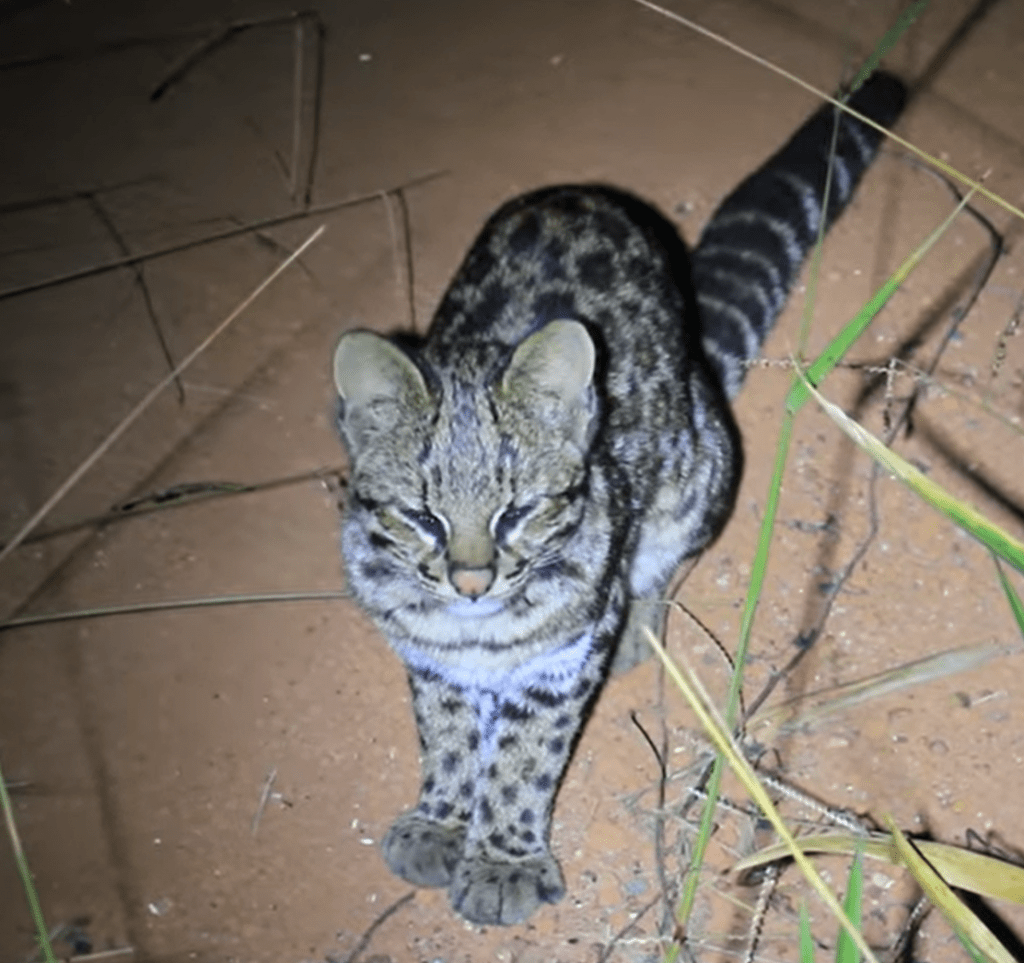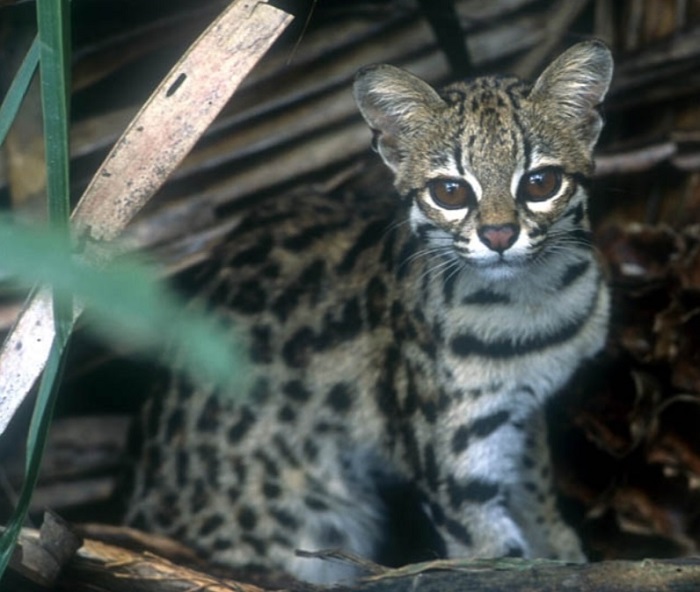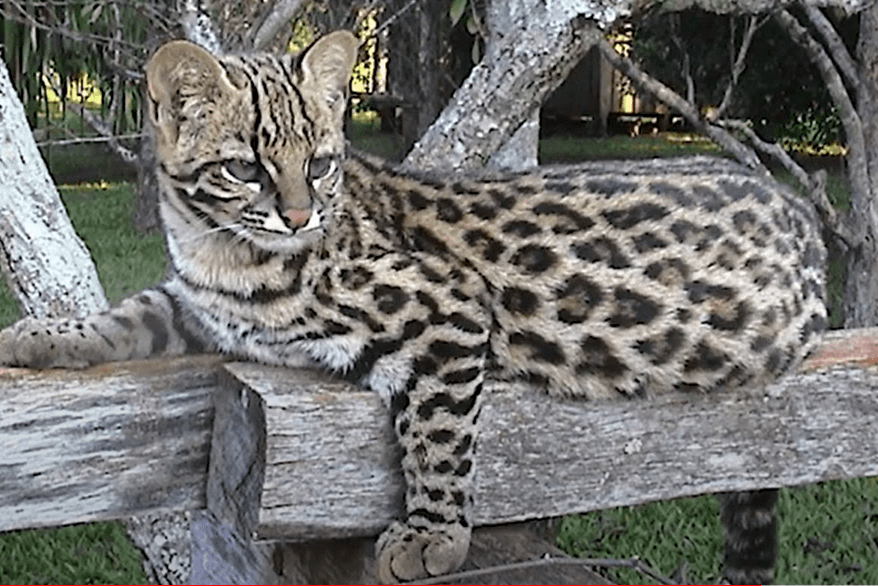The little, spotted Southern Tiger Cat (Leopardus guttulus) aka ‘Southern Little Spotted Cat’ is a fairly new wild cat species native to Brazil, Argentina and Paraguay. When found in the tropical rainforest of southern Brazil it was long referred to as an Oncilla, a Tigrina or a Tiger cat. A study of the cat’s genetics in 2013 found that it wasn’t interbreeding with Oncilla populations and had, as a result, become genetically distinct. So now these ‘Oncilla’ cats are referred to as either Southern Tiger Cats or Northern Tiger Cats (Leopardus tigrinus).
Cat of the Month ~ August 2020

Photograph: © Gustavo Pinto
Tiger cats are one of the smallest cat species in the Americas. A fully grown Tiger Cat can range from 1.8 kg to 3.5 kg in weight. They are nimble and extremely sleek animals, with a narrow but stocky head and neck, muscular shoulders and very large ears. The irises are golden or light brown. Males are generally larger than females. The fur of the Southern Tiger cat has a yellowish-brown ground colour, with large, rounded open rosettes of camouflage. Melanism is common. The paler belly fur is covered with dark spots.
The Tiger Cat’s fur is thick and short and does not turn forward in the nape region as it does on the Ocelot and Margay. Limbs are spotted on the outside and the long tail has spots at the root, developing into irregular rings with a black tip. The tail is short measuring just 60% of the head and body length.
The Southern Tiger cat ranges from Central to southern Brazil, eastern Paraguay and north-eastern Argentina. The northern limits of its geographic range are still unclear, so whether it overlaps with Northern Tiger Cats and to what extent is still not known. Sources state it reaches Central Brazil in the states of Minas Gerais, Goiás and the Atlantic forest of central-south Bahia in the northeast region.
The Southern Tiger cat occurs in a variety of habitats, from dense tropical and subtropical rainforests, deciduous/semi-deciduous, and mixed pine forests, to the open savannah, and beach vegetation. In the Pantanal (wet/swampy savannah), it is very rare and has been recorded only in the dry savannas, but not in the marshy areas.
The Southern Tiger cat also inhabits disturbed areas such as agricultural fields where there is an abundance of rodents but its occurrence is limited by the presence of natural cover. Both telemetry information and scat analysis indicate the cats do not venture into disturbed areas, but only skirt around their borders, where it has been shown that Rodent abundance is more pronounced.
Southern Tiger cats tend to avoid areas where the Ocelot is found in large numbers. As a generalist carnivore and the largest and most adaptable of the small cat species in tropical America, the Ocelot dominates the other small cat species. In fact the Southern Tiger Cats are in fear of being the prey of these Ocelots. This negative effect on other small cat species is known to scientists as “the ocelot effect”. When Ocelots inhabit protected areas, the smaller cats can be forced into adjacent unprotected areas, where the threat of habitat loss and human interaction is greater.

Photograph: © Gambarini on procarnivoros.org.br
The Southern Tiger cat has been observed as being a solitary felid. It is active predominantly at night, but can also show varying degrees of diurnal activity. This activity during any time of the day is suggested as a strategy to avoid the Ocelot. On the other hand, Tiger Cat numbers are not affected by the presence of the Margay and Jaguarundi, which are more likely potential competitors for similar sized prey.
Tiger cats are excellent climbers, but spend most of their time on the ground as most of their prey is terrestrial. When threatened, they show an aggressive behavior with arched back and raised hair, besides showing the teeth and producing a “whistling-spitting” vocalization.
The Southern Tiger cat’s diet is still very poorly studied, but is known to consist mostly of small mammals, birds and reptiles (especially lizards) and can include larger prey over 1 kg. This suggests that this small felid is a generalist predator, taking advantage of the most readily available resources in the area.
Very little information about the Tiger cat’s reproduction in the wild is available. Reproduction occurs year round, but could show different peaks in different areas. The gestation period lasts for 75-78 days, after which 1 to 3 kittens are born, but the normal litter is just one. The eyes are open at around 8 to 17 days. Weaning occurs at two to three months and young are about adult body size at 11 months of age. These felids are reported to have a lifespan ofs 15 – 21 years.
Southern Tiger Cat Conservation and Research organisations report that the global conservation status for the Southern Tiger Cat is Vulnerable (VU) and populations are declining. One of the Organisation dedicated to research and conservation of the smaller cats of Latin America: is the Institute Pro-Carnivores – Wild Cats of Brazil. Here is thier Carnivores – webpage showing the Shouthern Tiger Cat.



